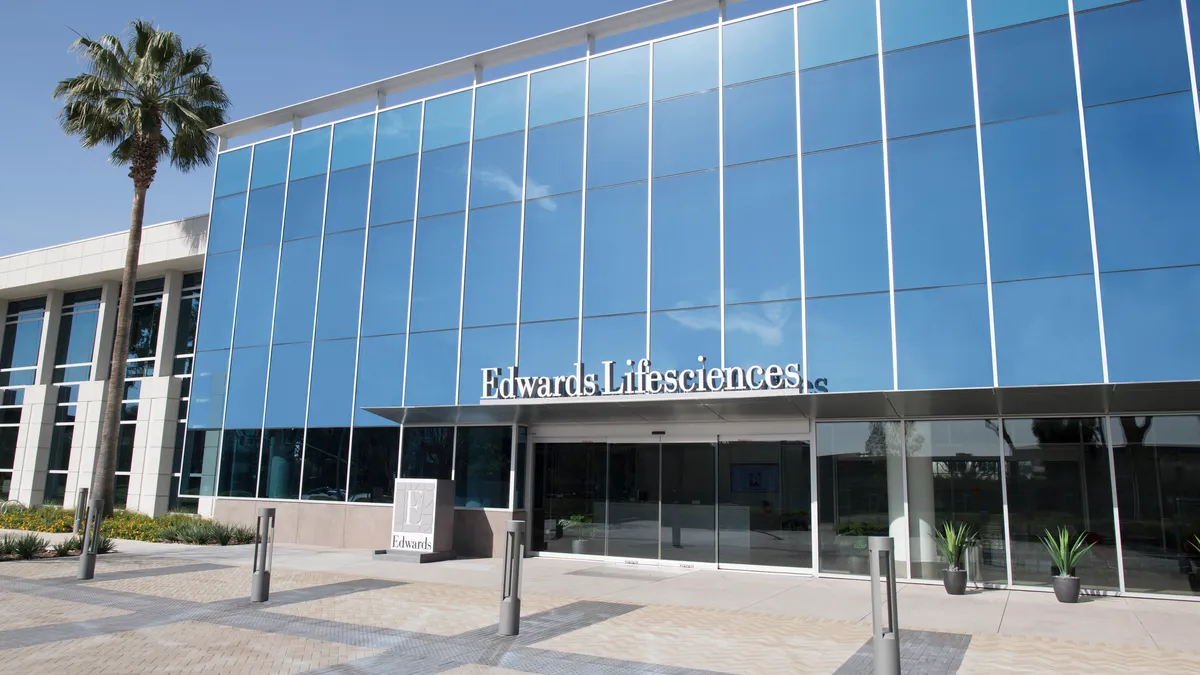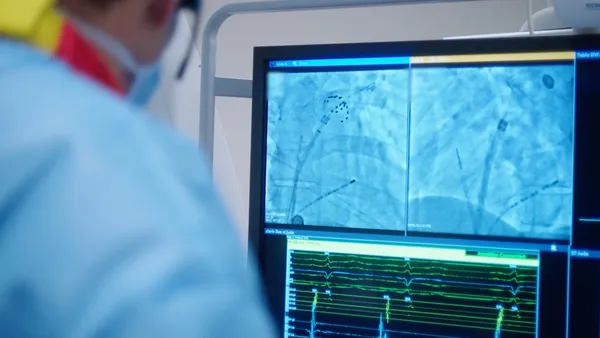Dive Brief:
- As the focus in transcatheter aortic valve replacement (TAVR) turns to use of the devices in younger, low surgical risk patients, Edwards Lifesciences' Sapien 3 demonstrated positive results in separate studies evaluating quality of life and long-term durability. Both Sapien 3 data sets were presented at the Transcatheter Cardiovascular Therapeutics (TCT) symposium in San Francisco.
- In a third study presented this weekend at the meeting, Edwards' older model Sapien XT valve was associated with rates of death and stroke similar to those seen in surgical valve replacement patients five years post-procedure. However, outcomes were not as good with a transthoracic TAVR delivery approach.
- Separately, data reported on Boston Scientific's investigational Acurate Neo TAVR device showed the valve was inferior at 30 days to Sapien 3 on the primary endpoint for safety and effectiveness in a head-to-head trial.
Dive Insight:
FDA approval last month of Edwards' and Medtronic's transcatheter aortic valves for patients at low risk of death or complications from traditional open surgery — in which the breastbone is split and the heart temporarily stopped — is expected to accelerate demand for the less-invasive TAVR approach, already the preferred treatment for high-risk patients. But not as much is known about how the implants will perform in younger and healthier patients who would presumably live longer with the devices.
The Edwards data released at TCT are encouraging for low-risk patients. Low surgical risk patients who got Edwards' Sapien 3 valve saw substantially greater quality-of-life benefits a month after implant than those who had open valve replacement surgery, according to results of the Edwards-funded study published in the Journal of the American College of Cardiology. The advantage persisted at six months and one year although the gap narrowed over time.
The quality-of-life results, comparing health status after TAVR and SAVR in low-risk patients, came from a sub-study of the important Partner 3 trial that demonstrated lower rates of death and repeat hospitalizations in TAVR versus surgery. The analysis used the Kansas City Cardiomyopathy Questionnaire, the Medical Outcomes Study Short-Form-36, and the EuroQoL to measure health-related quality of life in 943 patients with a mean age of 73.
Prior studies demonstrated early health status benefits with transfemoral TAVR — in which the valve is threaded through the artery to the heart from the groin — compared to SAVR, in intermediate and high risk patients. The new results for the low risk group showed quality-of-life improvements from TAVR were sustained over time.
With advancements in TAVR and surgeons' increased experience, the procedure has evolved into the standard of care for most aortic stenosis patients, from its beginning as an option for patients too frail to endure open heart surgery, University of Pennsylvania doctors said in an editorial accompanying the quality-of-life study.
In a separate Sapien 3 study, the Edwards valve demonstrated "excellent" durability equal to 25 years in accelerated wear testing, according to the researchers, who assessed hydrodynamic and mechanical performance in several sizes of the device. "As transcatheter aortic valve replacement expands to lower risk patients, durability will be of increasing importance," the researchers from St. Paul's Hospital in Vancouver, Canada, and Edwards Lifesciences said.
Five-year data from the Partner 2A study of Edwards' second-generation Sapien XT valve in 2,032 intermediate risk patients also were presented at the TCT meeting. The results showed similar rates of death and disabling stroke between TAVR and surgery seen at two years continued in the longer time frame, but with one caveat.
In the subgroup of patients who received valves via a transthoracic delivery technique involving a small incision in the chest, death or stroke was significantly higher at 59.3%, compared to 48.3% for SAVR, according to a TCT news release. The overall rate of death or stroke in the study at five years was 47.9% after TAVR and 43.4% after SAVR. In the transfemoral subgroup, event rates were similar at 44.5% for TAVR compared to 42.0% for SAVR.
In practice, surgeons have already gravitated away from the transthoracic technique. Vinod Thourani, chair of the cardiac surgery department at Medstar Heart and Vascular Institute in Washington, said 96% to 97% of patients are now being treated using the transfemoral approach.
The valve has remained effective in patients over time. "What we have learned is that the aortic valve area hasn't deteriorated in that five-year time period," Thourani said in a video provided by the American College of Cardiology. Patients in the study will continue to be followed to 10 years, he said.
Boston Scientific became the third device maker to enter the U.S. TAVR market when its Lotus valve gained FDA approval in April for use in high risk patients. However, data released at TCT on the company's in-development Acurate Neo device showed it failed to meet a composite safety and efficacy non-inferiority goal at 30 days in the head-to-head Scope 1 trial against Sapien 3. Kevin Ballinger, Boston Scientific's president of interventional cardiology, told investors the next-generation Neo valve will improve on the performance seen in the Scope 1 study.
A Cowen equity research note Monday that while the results for Acurate Neo are "certainly disappointing," but echoed Boston Scientific, saying that future generations of the valve may offer solutions.
"We would not expect Acurate Neo to be a workhorse valve at TAVR centers but believe head-to-head trials like SCOPE 1 can help delineate niche patient populations the device may be best suited for," the analysts wrote.










